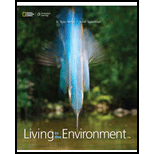
The reduction in percentage and the average distance driven that to reduce the annual carbon footprint calculated in Question 1 by half.
Answer to Problem 3EFA
The number of cars have to be reduced by 50 % or the average kilometers that a car be driven in one year have to be reduced to 10,000 km to reduce the annual carbon footprint calculated in Question 1 by half.
Explanation of Solution
Given info:
From Question 1, the carbon footprint per car produced by one car in a year is about 4 metric tons or 4,000 kg per year if on an average, it is driven 20,000 km in one year; at such a rate and assuming the total number of cars in the city to be 7 million, about 28 million metric tons (28,000,000 metric tons) of carbon dioxide is produced in a year.
It is given that an internal combustion engine in a car releases approximately 200 grams (0.2 kilograms or 0.44 pounds) of CO2 per kilometer if it is driven under normal driving conditions. Now, the approximate amount of CO2 released from a car engine cannot change all of a sudden. However, in order to bring down the annual emission of CO2 from a car, the kilometers it is being driven have to be reduced. The value for CO2 released from a car engine was obtained in Question 1 as 4000 kg/ yr. Half of this value is 2000 kg/yr
In Question 1, carbon dioxide released by the engine of a car in one year if it is driven on an average of 20,000 kilometers a year was calculated using the expression given below:
The reduction in the average car driven distance can be calculated by replacing the value for CO2 released by the engine of a car in one year with 2000 kg instead of 4000 kg and rearranging the above expression as given below:
Substitute 0.2 kg for the CO2 released by the engine of a car per kilometer and 2000 kg for CO2 released by the engine of a car in one year in the above expression to obtain the number of kilometers the car can be driven in one year to reduce the CO2 emission by half the value obtained in Question 1.
Hence, to reduce the annual carbon footprint calculated in Question 1 by half, the number of kilometers a car is driven annually on an average have to be reduced to 10, 000 km from 20,000 km, which means the number of kilometers were also reduced by 50%.
In Question 1, the total number of metric tons of CO2 that is produced by all the cars in the city in 1 year was be obtained using the given expression:
As of Question 1, the total number of metric tons of CO2 that is produced by all the cars, assumed as 7 million, in the city in 1 year was obtained as 28,000,000 metric tons when the number of metric tons of CO2 released by the engine of a car in one year was 4 metric tons.
Now, in order to reduce the value of CO2 released by cars in one year by half the value obtained in Question 1 (that is, half of 28,000,000, which is 14,000,000), keep the value of CO2 released by the engine of a car per year to be 4 metric tons itself; the above expression can be rearranged along with the replacement of some values. The equation then becomes as follows:
Substitute 14,000,000 for the total number of metric tons of CO2 that is produced by all the cars in the city in 1 year and 4 metric tons for the number of metric tons of CO2 released by the engine of a car in one year in the above expression to reduce the CO2 emission from all the cars in the city by half the value obtained in Question 1.
Hence, to reduce the annual carbon footprint calculated in Question 1 by half, the number of cars that can be driven annually has to be reduced from 7 million to 3.5 million, which means the number of cars have to be reduced by 50%.
Want to see more full solutions like this?
Chapter 22 Solutions
MindTap Environmental Science, 1 term (6 months) Printed Access Card for Miller/Spoolman’s Living in the Environment, 19th (MindTap Course List)
 Applications and Investigations in Earth Science ...Earth ScienceISBN:9780134746241Author:Edward J. Tarbuck, Frederick K. Lutgens, Dennis G. TasaPublisher:PEARSON
Applications and Investigations in Earth Science ...Earth ScienceISBN:9780134746241Author:Edward J. Tarbuck, Frederick K. Lutgens, Dennis G. TasaPublisher:PEARSON Exercises for Weather & Climate (9th Edition)Earth ScienceISBN:9780134041360Author:Greg CarbonePublisher:PEARSON
Exercises for Weather & Climate (9th Edition)Earth ScienceISBN:9780134041360Author:Greg CarbonePublisher:PEARSON Environmental ScienceEarth ScienceISBN:9781260153125Author:William P Cunningham Prof., Mary Ann Cunningham ProfessorPublisher:McGraw-Hill Education
Environmental ScienceEarth ScienceISBN:9781260153125Author:William P Cunningham Prof., Mary Ann Cunningham ProfessorPublisher:McGraw-Hill Education Earth Science (15th Edition)Earth ScienceISBN:9780134543536Author:Edward J. Tarbuck, Frederick K. Lutgens, Dennis G. TasaPublisher:PEARSON
Earth Science (15th Edition)Earth ScienceISBN:9780134543536Author:Edward J. Tarbuck, Frederick K. Lutgens, Dennis G. TasaPublisher:PEARSON Environmental Science (MindTap Course List)Earth ScienceISBN:9781337569613Author:G. Tyler Miller, Scott SpoolmanPublisher:Cengage Learning
Environmental Science (MindTap Course List)Earth ScienceISBN:9781337569613Author:G. Tyler Miller, Scott SpoolmanPublisher:Cengage Learning Physical GeologyEarth ScienceISBN:9781259916823Author:Plummer, Charles C., CARLSON, Diane H., Hammersley, LisaPublisher:Mcgraw-hill Education,
Physical GeologyEarth ScienceISBN:9781259916823Author:Plummer, Charles C., CARLSON, Diane H., Hammersley, LisaPublisher:Mcgraw-hill Education,





